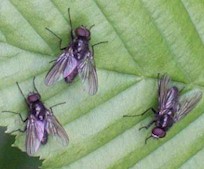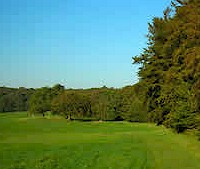The head fly (Hydrotaea irritans) ist a fly species that attacks sheep and other mammals. It is very common fly in vast parts of Europe with moderate climate, including Great Britain, Denmark, Germany, etc.
Head flies are especially abundant at the edge of forest nurseries and woodlands where they look for shelter when not feeding. They attack mainly sheep, but also cattle, horses, rabbits and humans as well.
They are usually not a problem for dogs and cats.
Biology, life cycle and behavior of head flies

Head flies are small to medium size Dipteran insects, 5 to 7 mm long with a black thorax and a dark green abdomen.
Adult head flies are not bloodsuckers, i.e. they do not bite, but feed on body secretions around nose, eyes and mouth, on organic debris at the base of the horns, on mammalian dung, etc. They are also attracted by blood of open wounds such as those caused by horse flies, where they congregate to suck blood. On sheep and horses they are mostly found on the head. On cows they congregate also on the nipples.
Adult females deposit their eggs in soil crevices or below fallen leaves, often in pastures, close to cowpats. The larvae are predaceous of other insect larvae. Larvae pupate and overwinter in the soil and the adults hatch late in the next spring, 7 to 10 months later. There is only one fly generation each year. The seasonal peak is usually in August.
Click here to learn more about the general biology of insects.
Harm and economic loss due to head flies
Head flies are extremely annoying for sheep, particularly horned breeds without wool on their heads. Large swarms may fall over a sheep flock and congregate on their heads. Sheep react with intense scratching and rubbing against objects, which produces open wounds. The flies congregate on such wounds and extend them. Such wounds attract also other fly species that cause cutaneous myiases. Stressed sheep may lose up to 10 kg weight per head due to this pest.
Head flies are usually less annoying for cattle, but they can transmit bovine summer mastitis, a disease of the udders caused by a bacterium (Corynebacterium pyogenes).
Prevention and control of head flies

Little can be done to prevent the development of head fly populations. Environmental treatment (e.g. with larvicides) is not possible because head flies do not breed on accumulated manure or organic waste, but scattered in the pastures.
In endemic regions, keeping flocks away from infested areas during the high fly season is often the best option. Once a flock has been attacked and sheep are injured, stabling the flock indoors may be the only option to prevent further damage.
Chemical protection can be achieved to some extent dipping or spraying sheep and cattle with synthetic pyrethroids (e.g. cypermethrin, deltamethrin) or treating them with ready-to-use pour-ons. Protection will last only 1 to 2 weeks after dipping or spraying and not much more than 1 month after pour-on administration.
On cattle, insecticide-impregnated ear-tags (mostly with synthetic pyrethroids and/or organophosphates) can achieve a longer protection of 2 to 3 months, but on cows protection of the udders is normally shorter, if at all.
So far no effective traps or repellents are availabe against head flies.
There are no effective biological control methods against head flies. Learn more about biological control of flies and other insects.
| If available, follow more specific national or regional recommendations or regulations for head fly control. |
Insecticide resistance of head flies
So far there are no reports on serious problems of head fly resistance to insecticides.
This means that if a particular product does not achieve the expected control, it is most likely because the product was not adequate or it was not used correctly, not because the flies have become resistant.
Learn more about parasite resistance and how it develops.